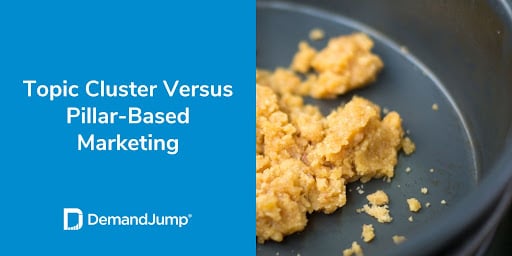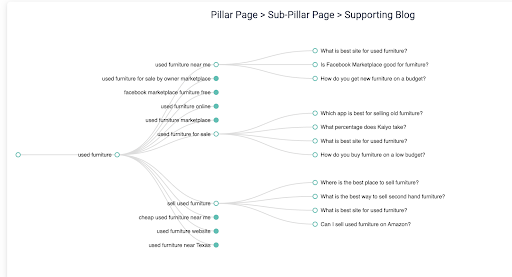Topic Cluster Versus Pillar-Based Marketing
March 28, 2023 •Andrew Gold

These days, marketers are constantly looking for ways to supercharge their SEO strategy. But, if they aren’t taking the right approach, they may face an awful lot of guessing, reworking, and trying to prove ROI on SEO content that just isn’t performing. That’s where topic clusters and Pillar-Based Marketing (PBM) come into play. But what do those terms really mean, and is one better than the other? We discuss all that and more in the following article.

What Is a Topic Cluster?
Essentially, a topic cluster (also referred to as a content cluster) consists of multiple pieces of content that are grouped together in some way—typically around a single topic or set of sub-topics. The idea is to provide enough pieces of content to address an overarching topic in-depth without covering it all at once in a single piece of content. If you were to examine a single piece of content within a topic cluster, you should be able to answer a handful of questions or learn a few interesting facts, but by no means would you know everything about the subject. On the contrary, if you (for some odd reason) read every single piece of content within a topic cluster, you would end up just shy of a subject matter expert.
DemandJump's podcast, Page One or Bust!, goes into detail on what a topic cluster is and how to make the most of Pillar-Based Marketing best practices. Below is a helpful clip discussing topic clusters. If you'd like to listen to the full episode, follow this link.
To help illustrate this idea a little better, try to recall the delightful snack, Clodhoppers. Clodhoppers were a staple of many a high school cafeteria and gas station in the early to mid-2000s. They were delicious pieces of graham crackers, all smashed to bits, covered in chocolate and sold in snack size bags. The idea of a content cluster is very similar to the Clodhopper.
Instead of eating a whole graham cracker or writing a huge article about your topic, you take something whole—in this case the content subject—and break it down into small bits. Then, you stick a bunch of those small bits—e.g. blogs or articles—together to create a whole from the sum of the parts. Finally, once the bits are clustered together, you add a little something extra to make them stick together more securely and taste a little better. That is essentially what a topic cluster does to marketing content. It takes a big complex subject, breaks it down into several pieces, and then ties them all together to make it easier for the reader to digest just the bits they want.
What Is an Example of a Topic Cluster?
There are practically infinite content cluster examples. Let’s suppose you run a business that re-sells used furniture. For a topic cluster, you might want to focus on the phrase “Used Furniture.” Within that cluster, your main topic would naturally be used furniture, but your sub-topics would potentially include:
- Used furniture for sale
- What is the best used furniture to buy?
- How to sell used furniture
These sub-topics each should have several even smaller topics to cover. This might look like:
- Used furniture for sale
- How can I find used furniture for sale near me?
- Who sells used furniture?
- Is buying used furniture less expensive?
- What is the best used furniture to buy?
- Is used furniture worth the money?
- What used furniture is the most durable?
- Is it good to buy used living room furniture?
- How to sell used furniture
- How can I sell furniture on Facebook?
- How to sell furniture at an auction
- Can anyone sell used furniture?
By now you may be thinking, “hmm, I am on DemandJump’s blog—the authority on all things Pillar-Based Marketing—and this notion of topic clusters seems a lot like PBM.” If that’s the case, then you’re on the right track!
Topic Clusters and Pillar-Based Marketing
The reality is that this blog title is misleading. Topic clusters and Pillar pages can (and should) be cooperative parts of your keyword clustering SEO approach. Instead of having to pick one or the other, it might be better to think about Pillar-Based Marketing as the framework for creating topic clusters.
What Is a Pillar Page?
A Pillar Page is the focal point of your content cluster or PBM strategy. It is a 3,000+ word article covering the majority of your subject on a broad level. It should bring up several sub-topics, but not foray too deeply into any of them.
What Are the Three Components of a Topic Cluster in PBM?
Using a PBM approach, the three components of a topic cluster are Pillar Pages, Sub-Pillars, and Supporting Blogs. Let’s apply the PBM framework to the “Used Furniture” example from above.
- For starters, your Pillar will be a 3,000-word article about used furniture.
- Next, your Sub-Pillars will be 2,000-word articles about sub-topics 1, 2, and 3 from earlier.
- Then, your Supporting Blogs will be somewhere around 750-word articles about the a, b, c, smaller topics within 1, 2, and 3.
Below you can see what the pillar plan might actually look like if you used DemandJumps platform!

How to Create Topic Clusters with DemandJump
Topic clusters and Pillar-Based Marketing are great components of an SEO strategy. But here’s the thing: without the right tools or data, they still involve guesswork and can be difficult to prove a return on investment. With DemandJump, you can take the guesswork out of it with our Insights platform. Our software will tell you exactly what topics to write about and even what keywords to include in your articles. As for ROI, with our platform, you track not only your own changes in page-one rankings, but you can compare your content to your competition. Skip the guesswork, skip the hassle, and jump into PBM today. Click the button below to get started.
Featured Articles
Categories
- Attribution Tracking (13)
- Channel Optimization (11)
- Consumer Insights (68)
- Content Marketing (251)
- Data Science (8)
- Digital Marketing (6)
- Digital Transformation (26)
- Enterprise (10)
- Lead Generation (14)
- Market Intelligence (8)
- Marketing Analytics (39)
- Marketing Attribution (57)
- Marketing Management (153)
- Marketing Operations (86)
- Organic Search (222)
- Paid Search (52)
- Pillar-Based Marketing (63)
- Programmatic Advertising (9)
- SaaS Content (14)
- SaaS Marketing (29)
- Search Marketing (111)
- SEO Keyword Research (28)
- SEO Pillar (18)
- SEO Strategy (46)
- SMB (5)
- Website Content (12)


